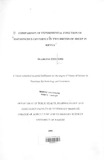| dc.description.abstract | The study described in this thesis was designed to investigate the hypothesis of
breed specific resistance to H. contortus infection in sheep in Kenya. The Red Maasai
breed, which was observed to thrive better than the other breeds of sheep in
Haemonchus endemic areas, was experimentally compared with the Dorper sheep. The
variables studied were, faecal egg count, packed cell volume, eosinophils count,
changes in antibodies, adult worm burdens and percentage of the established worms at
necropsy, the adult female worm length, male to female ratio and approximate
fecundity of the adult female worm.
Thirty six experimental sheep of each breed were bought from Laikipia District and
introduced to the National Veterinary Research Centre in Muguga (KARl), Kenya.
" They were isolated for a period of two weeks, then treated prophylactically with a
broad-spectrum antibiotic, vaccinated against haemorrhagic septicaemia and dewormed
with Nilzan ®. They were further confined for another two weeks, during which faecal
samples were checked for any nematode eggs; and were confmned negative. Blood
grouping was carried out and all the sheep were of blood group AA.
When all the sheep were confmned negative for nematode eggs, they were primed
weekly with 500 H. contortus L3 for a period of eight weeks. During this period they
were monitored for EPG, PCV, eosinophil count and antibody changes.
Priming was terminated at week nine and all the sheep treated with Nilzan ®. They
were kept free of infection for a period of four weeks. On examination of faecal
samples they were found negative for nematodes eggs. Some animals died towards the
end of the eighth week, the reason of their not was not known. Seven Dorper and
three Red Maasai were selected to act as controls. The rest (20 Dorpers and 19 Red
Maasai) were challenged with 5000 L3 of H. contortus. All the study variables except
EPG were monitored.
Serial sacrificing of the challenged experimental sheep was carried out on days 2, 7,
14, 21, and 28. Abomasal scrapings were collected for immature and mature worm
counts analysis.
Results showed that Red Maasai sheep had lower faecal egg count during the
priming period (P = 0.0023), higher pev values (P = 0.0001), higher eosinophil count
.' during priming (P = 0.0001), better antibody response (P = 0.0023 during priming and
P = 0.0393 after challenge). There was a significant difference during the "priming
infection". However, after the challenge, eosinophil counts were not different (P =
0.3887) between the two breeds. The control sheep of the two breeds were not
different from each other in all the variables i.e. pev (P = 0.1316), eosinophil count (P
= 0.8817) and ELISA O.Ds (P = 0.6729). Worm burden and establishment rates were
not significantly different between the two breeds (P = 0.9796), although the Red
Maasai sheep harboured fewer worms than the Dorper sheep. The adult female worm
lengths were not different (P = 0.1624) in both breeds. The results showed that the
Red Maasai sheep were relatively more resistant than the Dorper sheep.
The indirect approximation of worm fecundity revealed that worms from the Red
Maasai sheep during priming were less fecund than worms from the Dorper sheep.
However there was a great variability within each of the studied breeds throughout the
experiment.
It was observed in this study that the expulsion of adult worms occurred on day
fourteen in the two breeds after the challenge. This resulted in different worm counts
on day twenty-one with the Red Maasai having lower worm counts; but on day
twenty-eight the count in the two breeds rose to reach approximately the same level.
Since there was a high within breed variability, the degree of expulsion might be
different from one sheep to another; it is therefore, suggested that expulsion of worms
might have occurred in some sheep and not in others; and this could explain the rise
worm count on day twenty eight.
The rise in antibodies coincided with the expulsion of worms in the two breeds.
However, the rise was "rapid" in the Red Maasai and was sustained for a period of one
week, while in the Dorper there was a delay in the rise that lasted for a very short time.
These results were consistent with the earlier observations on the higher resistance
of the Red Maasai sheep to haemonchosis compared to other breeds of sheep. These
results further confirm the "genetic" abilities of the Red Maasai sheep to mount better
immune responses to H. contortus infection. Since the worm burden was similar in
both breeds. | en |

